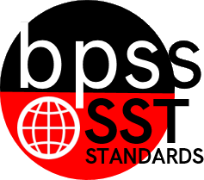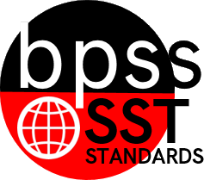5th Grade Social Studies (Archived)
 BPS District Social Studies Standards Book
BPS District Social Studies Standards Book
SST-05 "I can ... statements"
1st Grade Social Studies
2nd Grade Social Studies
4th Grade Social Studies
5th Grade Social Studies
7th Grade Social Studies
8th Grade Social Studies
| Prioritized Benchmarks |
SST-05.1.01
Student Learning Targets:Knowledge Targets
Reasoning Targets
Skills (Performance) Targets
Product Targets
Proficiency Rubric
ResourcesWebsites Helping Your Child With Social Studies
Vocabulary
| ||||||||||||||||||||||||||||||||||||||||
SST-05.1.04
Student Learning Targets:Skills (Performance) Targets
Product Targets
Proficiency Rubric
ResourcesWebsites Helping Your Child With Social Studies
Vocabulary
| ||||||||||||||||||||||||||||||||||||||||
SST-05.2
Narrative for the Important Historical EventsStudents in Grade 5 study the United States, focusing on the influence of physical and cultural characteristics on national origins, growth, and development up to 1800 through a formal exploration of United States history, geography, economics, government, current events, and cultural heritage. Emphasis should be placed upon study of Native American Indian cultures, European exploration, colonization, settlement, revolution against British rule, the founding of the Republic and the beginnings of the United States. Students also learn to describe the major components of our national government and to demonstrate responsible citizenship in the classroom and school setting. Through active learning experiences at the fifth grade level, students’ increasing interest in the ability to gather and organize data enables them to explore the physical and cultural characteristics of the United States and its neighbors. Students describe the historical movements that influenced the development of the United States from pre-Columbian times up to 1800, with an emphasis on the American Revolution and the founding of the United States. Calculation Method for StandardsStandards are larger groups of related benchmarks. The Standard Grade is a calculation of all the related benchmarks. Click on the benchmark name below each Standard to access the learning targets and proficiency rubrics for each standard's related benchmarks. | |
SST-05.2.03
Student Learning Targets:Reasoning Targets
Skills (Performance) Targets
Product Targets
Proficiency Rubric
ResourcesWebsites Helping Your Child With Social Studies
Vocabulary
| ||||||||||||||||||||||||||||||||||||||||
SST-05.2.04
Student Learning Targets:Knowledge Targets
Proficiency Rubric
ResourcesWebsites Helping Your Child With Social Studies
Vocabulary
| ||||||||||||||||||||||||||||||||||||||||
SST-05.2.07
Student Learning Targets:Knowledge Targets
Skills (Performance) Targets
Product Targets
Proficiency Rubric
ResourcesWebsites Helping Your Child With Social Studies
Vocabulary
| ||||||||||||||||||||||||||||||||||||||||
SST-05.2.08
Student Learning Targets:Knowledge Targets
Reasoning Targets
Skills (Performance) Targets
Proficiency Rubric
ResourcesWebsites Helping Your Child With Social Studies
Vocabulary
| ||||||||||||||||||||||||||||||||||||||||
SST-05.2.11
Student Learning Targets:Knowledge Targets
Skills (Performance) Targets
Proficiency Rubric
ResourcesWebsites Helping Your Child With Social Studies
Vocabulary
| ||||||||||||||||||||||||||||||||||||||||
SST-05.2.12
Student Learning Targets:Knowledge Targets
Skills (Performance) Targets
Proficiency Rubric
ResourcesWebsites Helping Your Child With Social Studies
Vocabulary
| ||||||||||||||||||||||||||||||||||||||||


 Standard 1:
Standard 1: